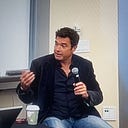2 min readAug 5, 2022
This short article briefly drops a marker as to several potentially new theories that are emerging from my text-based conceptual art and my self-study of its origins within broader art histories. The markers for future research and experimentation are:
- Are the earliest known cave paintings the original form of text based art? Could the figurative images of animals not only visually represent the animal and some other conceptual purpose, but also represent, by symbol, the sounds made by the various animals painted? What if those paintings were understood to convey not just a representation but also an audible noise associated with the animal, be that noise the animal’s own sound or the emerging human sound to identify it? If such a theory were to bear even some fruit, cave painting, then, might be fairly considered to be perhaps the original origin of text-based art or words in art.
- Building on the sound point: As long as the text in a text-based piece is legible, the viewer does not just “see” the piece; the viewer “reads” the piece. Even if only by working to identify the letters in the work. The “reading” of each letter, word, phrase, and sentence in a text-based work causes sound to be made if the viewer reads the text-based piece out-loud. Even if read silently, the viewer still “hears” the sounds of the text-symbols / letter-symbols in their head, since each letter (no matter the language) represents a phonetic sound. If all of this is true, aren’t at least some text-art pieces really also sound art? Variations on this theory is that text-based art is symbol- or system-based sound art; or visual sound; or even figurative sound. Text-based art, which may derive from cave paintings where animals depicted were not just visual but also cues for distinct audible sounds, may carry this DNA forward as the one type of art that can be “heard” and that can create “sound” as a function only of visual representation and mediums such as paint and charcoal — the same mediums used in the original cave paintings.
— Adam Wilson [drafted 8/4/2022; to be edited and supplemented with research].
